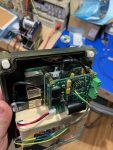A couple years ago as I was first investigating IoT plans from various cell carriers, I threw together a small Raspberry Pi based remote webcam and left it in the woods over winter. It worked well for several months, and then died due to an SD card failure in the Pi. The lessons learned, as well as a few improvements I had been thinking on have come together into version two.
A higher quality, more robust SD card was chosen for the Pi, and the main filesystem was made read-only to reduce chances of failure. An USB stick was attached to store the images separate from the boot OS to keep the write activity separate. A new LTE capable cell modem was selected to improve performance and potentially give better coverage with most focus these days on LTE networks rather than the older 3G networks. Finally, a custom control board was designed and built which handles MPPT (approximation) solar charging, battery management, timekeeping and alarms to wake the Pi on schedule, several environmental sensors, and finally the power regulation to run the Pi and cell modem from a LiPo battery.
It is currently surviving the winter at ~4000′ elevation on a mountain top, and is working extremely well. Future improvements will bring cost reduction so I can deploy more of them, and potentially some feature enhancements like infrared capabilities to capture photos at night, which I’ve found is often when significant weather events happen, and would be interesting to see.


